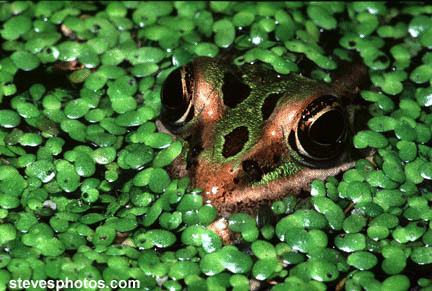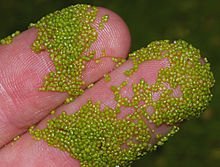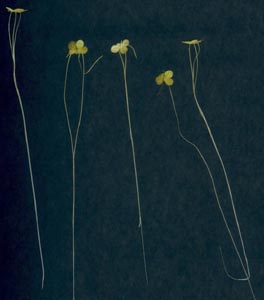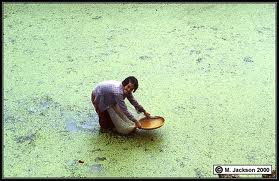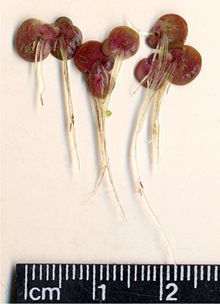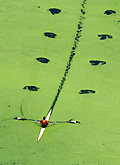A Weed Most Fowl
Do ducks eat duckweed? Yes and no. Do humans eat duckweed? Yes and no. Domestic ducks tend to eat duckweed, wild ones don’t. Humans can eat duckweed but …
Generally said there are three genera of duckweeds: Lemna, Wolffia, and Spirodela. Let’s start with Wolffia globosa which is used as a vegetable in Burma, Laos and Thailand. Its flavor is similar to sweet cabbage. Wolffia, which has the smallest blossom in the world, reproduces quickly making it a sustainable crop if the water is wholesome, which is a significant problem. In the wild, duckweeds tend to grow in poor water. Wolffia is 20% protein (more than soybeans) 44% carbohydrates, 5% fat has vitamins C, A, B6, and Niacin. Also called Khai-nam (eggs of the water) and Mijinko-uji-kusa, Wolffia is naturalized in California, Illinois, Kentucky, Tennessee and Florida. Unfortunately it is tiny, about 1/32 of an inch or the size of the eye of a needle. It’s a floating tiny disk with no root though it can have little hairs on its margin. It is so small it looks like meal floating on the water, hence its name watermeal. The tiniest and the tastiest. Best to raise your own in good water while keeping out lesser species.
Lemna is much larger than Wolffia. It usually has three attached floating leaves (called fronds) and at least one vertical root root per frond. Lemna, also called water lentils, is typically less than a quarter inch wide, some species an eight of an inch wide. Dried Lemna is used as cattle feed having up to 45% protein, 4% fat. Unfortunately, from the human point of view, it is also high in calcium oxalate. To quote Missouri Botanical Garden (www.mobot.org)
“Calcium oxalate is not a nutrient (nor a beneficial source of calcium), and it can be toxic in large doses. Duckweeds can contain up to 2 — 4 percent oxalic acid equivalents by weight. However, oxalate also is found in a great many leafy and very nutritious vegetables, including spinach, swiss chard and others. In these edible vegetables, calcium oxalate is found in at levels up to 0.5 — 1 percent. So, minimizing oxalate has the potential to make duckweeds more nutritious and digestible.
However, published reports of calcium oxalate levels in duckweeds are likely to be misleading. The late Vincent Franceschi (Washington State University) demonstrated that the calcium oxalate content of Lemna minor depends greatly on the calcium content of the water on which they are growing. Elevated calcium in the water favors formation of calcium oxalate crystals, and their content can be lowered by growth on low-calcium medium. It seems likely that placing duckweed on soft water for a reasonably short period could lower oxalate content significantly in a practical setting…
For people to eat duckweed, it would need to be grown under sanitary conditions. In addition, it may be desirable to pay attention to the calcium content. Evidence is now emerging that the absorption of dietary oxalate makes a major contribution to urinary oxalate excretion, particularly in stone formers. There is a patent on a method to select duckweeds for human consumption.”
To all of that I would add that perhaps some experimenting is in order. Dry heat has been used to break down calcium oxalate in other foods, Jack In The Pulpit comes to mind. Sometimes moist heat works, as in taro. Cooking — boiling or roasting — would also kill any bacteria et cetera on or in the duckweed from the water (high nutrient water is often caused by… duck droppings.) A second option, as some suggest, is to boil the duckweed, change water, then blend it. There is a practical side to that as well. Pistia stratiotes seedlings look similar, grow in the same place and time, and are the same size. They must be cooked.
Duckweeds are found in quiet, nutrient rich wetlands and ponds. They require high levels of nutrients to “bud” which means if a pond has a lot of duckweed the pond has excessive nutrients. Duckweed does not like moving water or windswept water even if the nutrients are high. Duckweeds bud. Under ideal conditions one duckweed frond can produce 17,500 “daughters” in just two weeks. With such high reproduction rate duckweed can cover the surface of ponds in just a few weeks. That is also why it is being considered for biodiesel because it has five to six times the amount of starch as corn. Duckweed also provides shelter for frogs, snakes, fish, insects and crustaceans. Grass Carp and Koi eat it. Perhaps the best way to to eat duckweed is to eat what eats it.
Giant Duckweed, Spirodela polyrhiza, was Lemna polyrhiza. There is one reference that says it has been used as food. Details are absent. I haven’t tried it. Giant Duckweed is frequently found growing in local rivers, ponds, lakes, and sloughs. In Florida, from the peninsula west to the central panhandle. It has two to three rounded leaves usually connected with each usually having several roots (up to nine) hanging beneath each leaf. The underleaf surface of Giant Duckweed is dark red. It can be easily confused with the exotic plant, Landoltia punctata. Landoltia duckweed is smaller than Spirodela polyrhiza, is more shoe-shaped, does not have a red dot on top, usually has only up to four roots, and sometimes has a red margin on the underneath of the leaves. It is spotted, as its name suggests.
Wolffia (WOLF-ee-ah or wolf-EE-ah) is named for Johann Friedrich Wolff, 18th century German botanist and physician. Spirodela (spear-row-DELL-ah) is from the Greek spira (spiral) and delos (clear), referring to spiral vessels clearly visible through the whole plant. Lemna (and various spellings) in Greek means port, which usually has quiet water. In fact, near my grandfather’s village in the Mani is a town called Lemeni. It’s at the end of a long, bay surrounded on three sides by huge mountains, and a cute hotel clinging to a cliff.
One last point: Frankly I think using an old swimming pool or the like to raise duckweed in would be the best. In natural ponds duckweed tends to collect detritus. A handful of duckweed includes a quarter handful of debris. It can be an aquaculture crop but it would take some planning.
PS: The leopard frog is edible.

